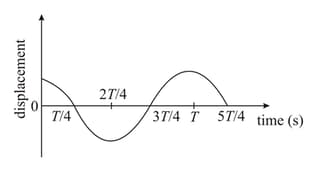EASY
Earn 100
A particle performs simple harmonic motion. A large number of snapshots of its position are taken at random. A histogram of these positions will
(a)have a minimum around the mean position.
(b)have a maximum around the mean position.
(c)resemble a sinusoidal curve.
(d)be almost flat.
33.33% studentsanswered this correctly
Important Questions on Oscillations
HARD
MEDIUM
HARD
EASY
HARD
MEDIUM
EASY
Which one of the following graph shows correctly the variation with ?
EASY
HARD
EASY
EASY
EASY
MEDIUM
In case of a simple harmonic motion, if the velocity is plotted along the -axis and the displacement (from the equilibrium position) is plotted along the -axis, the resultant curve happens to be an ellipse with the ratio:
What is the frequency of the simple harmonic motion?
MEDIUM
The displacement time graph of a particle executing SHM is given in figure: (sketch is schematic and not to scale)

Which of the following statements is/are true for this motion?
(A) The force is zero at
(B) The magnitude of acceleration is maximum at
(C) The speed is maximum at
(D) The is equal to of the oscillation at
EASY
MEDIUM
EASY
MEDIUM
EASY
HARD

